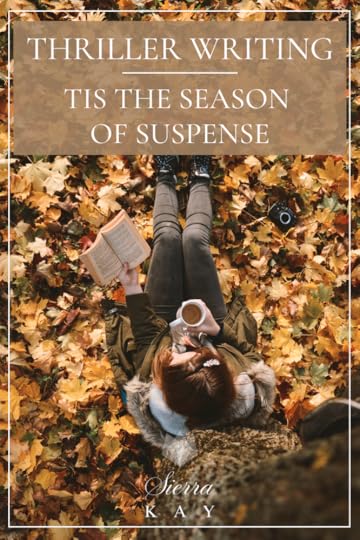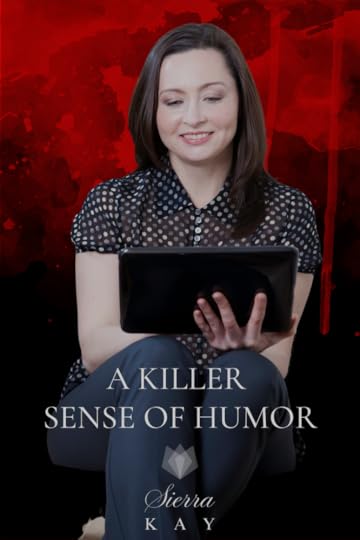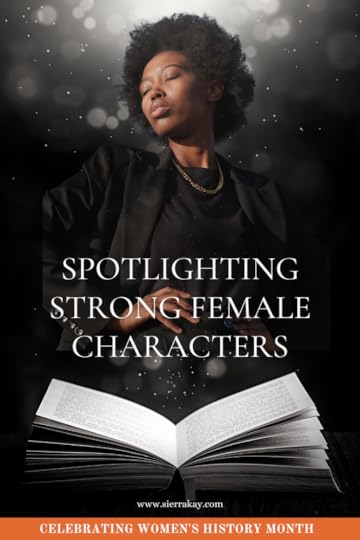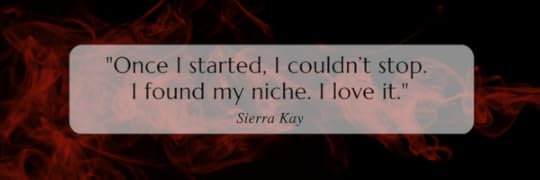Sierra Kay's Blog, page 3
October 2, 2023
Thriller, Thriller Nights
It’s that time of year again, when the tilt of the earth shifts the sunlight into a mysterious soft glow. Leaves are dropping, squirrels are gathering, and the air and entertainment are spine-chilling. It's the perfect time for thrillers.

So pull out your favorite soft throw, cozy up with a warm drink and lose yourself in the layers of a page-turning suspense novel. Or, if you’re of the story-telling sort, write one of your own! The imagination is a wondrous thing, and spending these transitional autumn days building tension and suspense in your own book only adds to the delight of the harvest season.
Thriller master Sierra Kay had a bit to say about the season of suspense, tension and crafting stories that keep readers on the edge of their seats.
So what is about autumn that makes thrillers more prevalent on the entertainment radar?
“The days are shorter and the joy and energy from the summer sunlight is fading. There’s less light and more darkness, lending more opportunity for the nefarious to occur,” says Kay.It's hard to see in the dark and difficult to predict the next step when there is a mystery unfolding. This sense of unknowing is how authors build suspense. They lead the reader through the dark forest to the house made of gingerbread, but will they be eaten alive?
This is the question that builds suspense.
Thriller writing is a special genre that requires a mind adept at puzzle-working. There are typically a lot of moving pieces. To Kay, this is part of the draw.
“I like the complexity of thrillers and the thought behind all the layers that you have to weave into a cohesive story,” Kay said. “There’s an art to the bread crumbs you leave for the reader.”
A strategy Hansel and Gretel would no doubt be proud of, as they know leaving bread crumbs will eventually lead them and the reader back home and to the culmination of the story.
To Kay, the bread crumbs, or the building of suspense, is a foundation of thriller writing.
“I build suspense by embracing the unknown. You know something is going to happen, but you don’t know what,” Kay said.
Using emotion to build Tension is A go-to tactic for getting the reader to care and feel.“If no one cares about the unknown then you are just on an island writing for yourself,” Kay said. “If the character knows the killer is after them, they have an emotional reaction to that. There is tension in their every movement. They can’t eat, they can’t sleep and you as a reader {or writer} feel that tension with them.”
One of Kay’s favorite moments of tension were in 30 Days of Pleasure when main character Alicia Mitchell is having an amorous dream about her new love interest, NBA star Dallas Avery. Suddenly, in her dream, she hears the words Hey Sugar… but it’s not Dallas and she’s triggered and we soon learn it's the voice of her stalker haunting her sleep.
"Hey Sugar.......Those two words should have been innocuous, but because of who they came from, they were terrifying,” Kay said. “The reader wants to know what this guy has done to her.”
Will the stalker catch up with Alicia? Has he already? She checks all four corners of the hotel room...
One bread crumb leads to another and another, creating anticipation and thrilling the reader as they make their way home to the climax.
Kay's advice to those entering the dark forest of suspense writing is to read.
“Focus on your genre, read it and expand your mind,” Kay said. “And don’t be afraid. Be a little bit crazy and ignore the people who would look at you oddly. Be fearless.
Save the fear for your characters and your readers.
your Sierra Kay Takeaways: Embrace the season - Use the autumn ambience as a catalyst to writing. Notice the shadows, the temperature and sounds that go bump in the night. The Hansel + Gretel Approach - Build suspense through uncertainty. The use of bread crumbs is leading the reader home, but they don't know what danger they'll encounter on the way there. Leave impossible questions and shocking answers as you lead your reader to the climax. Create Tension - Create tension through emotion. This is a show not tell technique that draws the reader in by detailing the characters reactions to their situation. Do not underestimate the power of emotion in building tension. Be Fearless - Read and write fearlessly. Ignore the outside world and let your Hansel and Gretel guide you through the story.What Sierra Kay Take Away are you ready to implement?

Pin it to save for later!
Follow Sierra Kay on Pinterest.
Click the hashtag for more #writingtips
Follow Sierra Kay down the modern fairy tale rabbit hole by visiting her book library ,here.

September 1, 2023
Writing What You Love

What topics do you love to write about?
Maybe you're a journalist, who is writing to pay the bills, but really loves to write romance novels in your spare time. Or maybe you're pumping out beach reads for a paycheck but long to get back to the non-fiction book on ancient Greece that leads you down rabbit holes of wonder. Or, if you're blessed, you might be writing exactly what you love and reaping all the benefits! In this blog post we will explore what it's like to write what you love, and why writing what you don't love, isn't all that bad either.
Writers beginning their author journey don't always know what they love to write about. Thriller author Sierra Kay says this is normal, and she hasn't always written what's smitten her.
"I've explored other genres. Writers need the exploration to find out what they do like."
Writing what you love comes in many forms; it's not just genre based, it can be very specific. For instance, Kay says her characters and their dynamics are what drive her to the keyboard. Women's fiction and the relationship between female friends are a few of her favorites.
In addition, she says that with every book she writes, she loves exploring the spectrum of good and evil. For instance, a good character can swing hard when put in a precarious situation.
"Look at Antoine from Sweet Whispers of the Devil. He's a good guy, but when his family is threatened he turns into someone else, and is ready to go to war," Kay said.
How do you know if you are writing what you love?
One of the best indicators if you are writing what you love is if the world falls away while you are in the midst of the process.
Kay said a writing exercise, taught by one of her former instructors, has led to one of her favorite novel passions.
"I lose track of time sitting my character down in a chair and letting him or her talk," she said.
By doing this she learns about what motivates the character, whether it be the hero or a killer. She let's the character drive the story.
"If a book has never woken you up, you might not be writing what you love," Kay said. "When you love a book you're working on, you mind is constantly working on it. Keep a notebook handy."
She also said, that the phenomenon of having random epiphany moments about your book are a good indication that you are on the right track.
Is not writing what you love a waste of time?
Kay says no way! Writing is writing. "I don't consider it negative to note be writing what you love. You are exploring and you are still writing and working that muscle."
So, do you HAVE to be writing what you love? Not at all! It may be financially lucrative to write other works, but you can keep your side projects and let them be your labors of love.
your Sierra Kay Takeaways:Are you looking to discern what you love to write?
TOPICS - What topics have you diving down the rabbit hole? Trust me, it can be many! LOSING TIME - What was the last writing session that made you lose track of time? Explore the chapter or paragraph or book. What about it kept you captivated? WORK IT - Not all writing has to be what you love. You can write what you need to and write what you love. The bottom line is this...WRITING IS WRITING IS WRITING IS WRITING.
Now go write!
What Sierra Kay Take Away are you ready to implement?

Pin it to save for later!
Follow Sierra Kay on Pinterest.
Click the hashtag for more #writingtips
Follow Sierra Kay down the modern fairy tale rabbit hole by visiting her book library ,here.

August 1, 2023
A Killer Sense Of Humor

Sierra Kay is known for writing fiction with a thrilling psychological edge. The suspenseful pace, the twisting plotlines and the memorable characters all keep us coming back for more. There’s no denying that these stories keep readers on the edge of their seats to the jaw-dropping end.
But look closer and you’ll find something that makes the books even more enjoyable. You may sense the undertone of humor sprinkled throughout her work. Because Kay’s writing is so character driven, the use of humor isn’t so much a strategy as it is an unfolding that develops as the character’s reveal their personalities and intentions.
“A lot of times it’s unintentional. When you are true to your characters those emotions just come out,” Kay said. “Humor is often how a particular character would react.”
Kay's own sense of humor developed when she was younger. Then it came out as sarcasm and snarky comments. “Comedy hits everyone differently,” she said.
As an adult she was bitten by the comedy bug when a friend was putting together a comedy show for Second City in Chicago. Kay hung out with them and thought, “Oh I can do that!”
She wrote a sketch, honed it and it went over well. “You use a different writing muscle for that, but it’s always been fun.”
Kay wrote sketches for seven years, until the theater experience came to an abrupt halt during Covid, and many haven’t had a chance to return.
 Kay with sketch comedy group pals.
Kay with sketch comedy group pals.As for writing humor in fiction, Kay says that what helped her a lot when she was getting started was the level of freedom that she didn’t possess prior to it. “It’s about pushing the limits,” she said.
“Because I write thrillers and it’s heavy material, it’s my hope to use humor to lighten it up a bit,” Kay said.
So what are some of our favorite funny lines from the Kay bookshelf?
We love Monique in Sweet Whispers of the Devil:
“Your mother should’ve let me shoot that bastard years ago,” Monique growled. She hailed from the Louisiana bayou and prided herself on her ability to shoot an alligator’s eyeball. Her ballsy stance seemed contrary to her job as a social worker. She explained once, “There is nothing that keeps folks in line like the potential for a bullet in the ass.”
Monique epitomizes the sassy snark Kay is known for. It can cut through a tense moment with razor sharp perfection. Even her metaphors make us chuckle:
“The Auberts couldn’t gain a pound on a diet of pork rinds dipped in sugar.” - Sweet Whispers of the Devil
Are you looking to develop your killer sense of humor in fiction?
your Sierra Kay Takeaways: EXPERIENCE - Get involved in local groups or look for stand up opportunities. Try improv night or sketch comedy writing. Not an extrovert? Go see a live performance or study them on tv. Note the timing and know the audience. FREE YOURSELF - Go on a writing spree with the intention of adding some humor. Let yourself explore without judgment. Is it funny to you? Let another read it. Is it funny to them? TRUST THE CHARACTERS - If your character is known for having quick wit, allow it to shine through, oftentimes in the most tense situation. REFINE - Have you ever heard someone tell a joke and it just falls flat? Don’t let this happen in your writing. Tweak and hone the humor until it lands with perfection. HAVE FUN! - Adding comedy, especially in thrillers, can be just the touch of fun it needs for the book and for you as a writer!What Sierra Kay Take Away are you ready to implement?
Check out a sample of her comedic work ,HERE.

Pin it to save for later!
Follow Sierra Kay on Pinterest.
July 1, 2023
Process Makes Perfect
Creating a personalized process to maximize your writing time.

It has often been said that a writer must write everyday in order to create worthwhile work and perfect their craft.
Some say this is indeed the way, while others believe it is literary dogma that deserves to be challenged.
So is everyday writing necessary or subjective?
We say:
Know thyself, writer.Just as all people learn differently, not everyone writes the same way either. Knowing yourself can help you determine the most effective writing practice for you.
Seasoned writers, like best-selling author Sierra Kay, are able to produce a prolific library of published work because they respect their schedules and how their creativity flows.
Forced writing time, when there isn’t any time to be had, can induce stress, blocking the vision and dampening the author’s experience.
Much of writer’s block can be attributed to the pressure to produce something every single day.It can also disrupt the creative flow.
“If I sit down to write, then have to get up and leave a scene, it won’t be the same when I return,” said Kay. “I want the time to sit down and get in the zone.”
For Kay, it’s less about a disciplined schedule, and more about writing time that is free from interruption and distraction. When those doors open, she happily walks through and commits herself to the characters and the story.
Perhaps you are a freestyle writer or maybe you like the structure of an agenda. Taking certain factors into account like your schedule and when you feel most creative can help you develop a process that is tailored to your style.
Some writers are morning people, some come alive at twilight, some need a few days of unbothered focus, while others can appreciate twenty minute work breaks or their child’s nap time to knock out a scene, chapter or their targeted word count.
Your process will depend on what feels natural and non begrudged, in cooperation with the time that you have.“I write every week, but not everyday,” said Kay. “Everyone has a different process. I personally want the time to dedicate to writing, and I don’t necessarily have that everyday, but I do have time every week.”
Kay also says that a writing practice isn't limited to manuscripts or one genre. Poetry, skits, journal entries and even notes can be a way to work your creative muscles.
“My mother was a great letter writer,” said Kay. Which is a beautiful and personal way to keep your writing skills strong, whether it’s done everyday or once a month.
Writing everyday may sound good and well-intentioned, but it’s not for everyone. Holding yourself to a disciplined everyday writing habit can seem daunting, discouraging some would-be writers from even getting started. However, writing everyday may be exactly what some need to stay disciplined and focused.
Taking the time to discover what writing style works best for you is the key.“Writing everyday is not my process and that’s okay,” said Kay.
Kay’s advice is simple and straightforward: “Find the practice that works for you. Not everyone is going to do it the same way, but do something,” said Kay. “Be active in your active writing.”
These days, there are all sorts of distractions to keep us from our craft. Don’t let the everyday writing narrative be one of the distractions that throws you off path. The most important thing is to find a process that works for you and then follow through.
Remember, improving your writing skills can come in a variety of ways, but if you are interested in creating a disciplined writing process give these tips a try.
CREATE A PERSONAL WRITING PROCESS:
Evaluate how you spend your free time. Discover when you are the most creative. Determine where the two intersect. Zero in on that slot and schedule it as uninterrupted writing time. Draw boundaries around this time with work, friends, and family. Remove distractions like phones, pets and tv. Make sure you have the materials you need when you sit down to write. Prime your mindset with a notification a half hour before you sit down. Find what motivates you. Is it word count, page count, chapter completion, scene completion, or simply putting an idea on paper before it escapes? Reward yourself when you are done. A simple pat on the proverbial back will even work! Give yourself a grace period to get into the consistency groove.Now get to writing, writer!

Pin it to save for later!
Follow Sierra Kay on Pinterest.
June 1, 2023
Show and Don't Tell
Using sensory details to paint a picture in your reader's mind.

Show don't tell.
If you’re a writer then you've probably heard this sage piece of advice repeated over and over again. But what exactly does this phrase mean and why is it so important for storytelling? Let’s take a deep dive and explore this topic.
SHOWING
In a literary sense, showing is delivering story information, but in a way that evokes emotion. It is a method of storytelling that puts the reader in the room or even in the shoes of the characters and gives them a bird’s eye view.
TELLING
Telling also gives information about the story. It could be a concise delivery of a sentence or pontificated on for pages and pages. No matter the length, telling is simply reporting what is happening without feeling or depth.
So why don’t we want to simply tell?
Telling can seem flat and lifeless, which makes it difficult for readers who want to escape into a story and connect with characters. If too much telling is used, the storyteller risks losing the reader's attention.
Think pages of monotonous passages. Can you remember reading a book that you just couldn't "get into?" The author was probably doing too much telling and not enough showing. Telling is boring and makes focusing difficult. The reader is more likely to put the book down and not pick it back up. And worse yet, give a bad review or unsavory word of mouth.
On the other hand, showing keeps the reader engaged through description, emotional pull and full use of the senses. Take this case study from Sierra Kay’s At the Touch of Love as the main character, Echo, waxes nostalgic on the dichotomy of her birthday and the anniversary of her parent’s death:
,“While her parents were probably screaming at the drunk driver speeding towards their car, she was laughing at her roommate's jokes. While her parents' black Saab crumbled under the impact of a blue Cadillac, she was shaking her ass to the sounds of Prince's "Let's Go Crazy" blasting from the apartment stereo. While her dad ricocheted in the interior and her mom was thrown out of the window to land on the concrete yards away, Echo had kissed a boy she didn't really like. She merely thought he was kind of cute.”
In one impactful paragraph the reader simultaneously experience’s a car wreck, a party {you can hear the Purple One crooning on Crazy}, and deep grief all by showing. The story goes on:
,“When she received the call, she passed clear out. When that call came through, the voice on the other end spoke to dead air. The world had faded out of focus and she opened her eyes as someone picked her up from the floor. She didn't remember what the caller said. They were gone—just like that. What only child survives something so tragic? If loneliness doesn't make a person check out on life, guilt surely will.”
The sorrow and guilt is palpable. You can feel the what ifs and how comes swallowing Echo whole and as if they are happening directly to you. As a reader you want to know more about Echo. You keep reading to know how she survived the tragedy and moved forward or if she even could. The reader is moved forward by the showing of the scene.
“When an author shows, the reader becomes more involved in the journey and they are less likely to scan the pages. They want to be in the moment with the characters,” author Sierra Kay said. She’s penned six novels all with the show don’t tell philosophy in mind.
Kay says by using the show don’t tell method, she is able to center herself in the story’s experience, making her writing richer, less formula-driven and more meaningful. “Showing breathes life into the story. Page numbers and word count don’t matter when a writer is engaged with their story in this way.”
Showing breathes life into the story.
Showing uses the senses to stir the spirit. “Showing is setting a character in the middle of a room and describing what is happening to her,” Kay said.
So how can you use the senses to transform a scene? Consider these prompts.
,SIGHT, - What are the characters seeing? Is it shocking, loving, tender or tough? ,SMELL - What scents are impacting the scene? Are the lilacs in full bloom as the lovers stroll toward their demise? HEAR - What do they hear? Is it Prince or Harry Belafonte? Is it a train coming down the line or a doorbell? A shotgun? A whisper? TASTE - What is heard? Is it a warm chocolate chip cookie fresh from the oven or the metallic taste of blood? TOUCH - What is being felt? Is it cashmere, sandpaper, a velvety bloom or a knife slicing through skin? Deep love? Or jealousy so toxic you can see the pages turn green?Are you a writer? How has showing transformed your writing?
Click the hashtag for more #writingtips
Follow Sierra Kay down the modern fairy tale rabbit hole by visiting her book library ,here.


Get notified of new blog posts when you sign up for Sierra's monthly newsletter here.
May 1, 2023
Know Your Audience
Writing for the people who will read your work

Knowing your audience is a common catchphrase in the book industry these days. It’s a noisy world out there, and marketing your books to everyone will most likely get you no one. So how is the modern writer to know who her audience is? Sierra Kay, author of six novels, has some sound advice on this hot topic.
“Oftentimes your audience finds you. You just have to put your work out there, and the response you get will reveal your audience,” Kay said.
The worst way to find your audience is by analysis paralysis.
Be courageous by letting your book be the magnet; your audience will be the steel.
Once your work is out there, then it’s time to seek the feedback, and knowing where to find it is crucial. Kay says that newsletter replies and book reviews are a few ways the audience reveals itself.
Connecting with readers in-person is also a very important part of the audience equation, as Kay says feedback given at live events gives her tremendous insight.
And how does knowing your audience on this personal level affect the creative process?
“It’s a reminder that you don’t want to disappoint the reader. You want your work to be of value, entertainment and worth their time and effort,” Kay said. “It’s like a contract with your reader. And I would rather overdeliver than underdeliver.”
She also recommends a third party analysis of your work, as the unbiased eye can provide you with invaluable information. Through this tactic, she knows that her readers tend to be women who enjoy mysteries and psychological thrillers.
Once you know who your audience is, it’s important to know what they like about your work. This requires paying attention to the feedback and sorting through responses to get to the gold. In Kay’s case, this includes havoc with a twist.
“The stories I write are filled with mayhem, and my audience loves the plot twist at the end. This surprise keeps them coming back for more.”
Allowing her characters to drive the storyline and hooking the reader with layers rich in question and answer, has been a winning writing technique that her audience loves.
“I have always liked the intrigue and challenge of writing mystery. My books are not written for a quick read. It’s for the people who want to dive into this multi-layered world of intrigue,” Kay said. Knowing who her readers are and what they want keeps her writing with purpose.
So writer, as you move forward on your author journey and seek to know your audience keep these points in mind:
Put your work out there! Don’t get hung up on the details. Put it out there and let your audience come to you. Know where to find the feedback. Newsletter replies, social comments and reviews are all filled with important audience information. In-person connection. Connecting with your readers at in-person events can give you invaluable insight and delight. Meeting your readers is rewarding to them and you, plus you learn from them, and hold yourself more accountable to deliver. Third-party analysis. Having an unbiased set of eyes will uncover a lot. Marketing experts, publicists and even beta readers can be great resources. Dig into the feedback. Now that you know where your feedback is coming from, look deeper into the details. You will uncover a wealth of information and validation.Have you found your audience? What do they enjoy from your writing? Comment below we want to know!
Follow Sierra Kay down the modern fairy tale rabbit hole by visiting her book library ,here.


April 2, 2023
Once Upon A Time
Once upon a time might be the most recognized opening line to start a book. And while Sierra Kay loves a good fairy tale storyline, her opening lines pack a punch that might inspire the big bad wolf to blow the whole darn house down.

Echo Sherise Charles died on the same day she was born.
Are you hooked?
Her son was gone.
How about now? Itching for more? Then keep reading.
Seraphina Brooks Glen bit her lip, trying to ignore the stab of uncertainty that filled her as she looked up at the four-story brick structure in the affluent area of Lincoln Park.
What do these sentences have in common? If you guessed they were all the beginnings of Sierra Kay novels, you’d be right. Each book has a powerful opening scene that starts with a bang and hooks the reader from the get-go, reeling them into the story at hand.
We asked Sierra Kay about the writing process and how she starts her books with such powerful emotion.
“I usually start with the voice. I do the character work and then go back and see if it’s captivating enough.”
Sierra Kay novels are very character-driven with a three-dimensional style that makes them seem real. How real are they for her?
“Sometimes you wake up at 3 am with an epiphany, and sometimes the character talks to you, such as Behind the Curtain. That first chapter is built upon building interest in the murder,” Kay said. "It's written to pique your interest about what in the world just happened. It was about focusing on the mind of the murderer."
A bone-chilling excerpt from ,Behind the Curtain:
Killing seemed so easy now. But there were other ways of silencing people. Pain worked much better. Watching people break down and promise things that they never dreamed was ... exhilarating. Twenty-four hours was all it took. Cops didn’t even stir before then. And by then, most little pawns were returned to their homes. Broken. Pliable. Mine.
“In Queen of North Shore, it was more about trying to convey this deep sense of sadness, so I was really focused on Solange being by herself in the beginning. She was dealing with her new reality and you’re mired in her sorrow.”
This anguished excerpt is from ,Queen of the North Shore:
Solange Porter stood alone on the expansive balcony. Death was a jealous companion. It dragged beauty out the back door and replaced it with swollen, sunken eyes, the absence of color and joy.
Are you feeling the feels too? The grief is palpable. We love it when an author can get us to experience emotions vicariously through the characters, and Sierra Kay nails it with her opening scenes.
Whether it’s a peek inside the twisted mind of a killer, experiencing the deep sadness of a widow, or the sheer terror of a mother whose child has been kidnapped, Sierra Kay openings make you feel deeply and keep you reading until the end.
Which Kay novel has your favorite beginning? Comment below!
Follow Sierra Kay down the modern fairy tale rabbit hole by visiting her book library ,here.

March 1, 2023
Every Woman Has A Story To Tell
March marks Women’s History Month in the United States, corresponding with International Women’s Day on March 8. This is a month to remember and reflect on the women who have come before us, who are walking beside us and the next generation who are being raised by us. Whether it's fiction or fact, we recognize that every woman has a story to tell.
 Spotlighting strong female characters.
Spotlighting strong female characters.Tenacious, clever, feminine and steadfast. Those are just a few words used to describe the strong female leads that grace the pages of Sierra Kay novels. All of Sierra Kay’s female characters possess the fortitude it takes to overcome adversity. Whether it’s Solange from Queen of the North Shore, dignified and capable who in her grief must rise to the occasion and face unspeakable betrayal or Victoria from Sweet Whispers of the Devil whose grit and wisdom gives her the strength to fight the nightmare that comes to call. Kay’s female leads are tough.
“It might be one of the reasons that I’m drawn to fairy tales,” Kay said. “Anyone can be strong. The evil characters are most likely female. The leads are often female. Cinderella, Snow White, Red Riding Hood....
They’re all females trying to figure out how to survive."And how exactly does Kay paint such grim pictures for the female leads to escape or overcome?
“Often the dark situations are derived from the books from which the stories are based on. Let’s take In the Midst of Fire for example. It’s based on Hansel and Gretel. In the book you have twins that are captured by a witch. Hansel is trapped. Gretel is free, but she’s tethered to the situation, not just because of the fact that there is a witch, but because Hansel is trapped.”
With such amazing female leads, we had to know if Kay had a favorite.
“Honestly, my favorite lead changes depending on the story I’m writing. I write to make everyone love my lead as much as I do. Give them layers, challenges, place them in the middle of situations that promote their growth as characters,” Kay responded.
"I write to make everyone love my lead as much as I do."These cultivating experiences reflect the growth we as women go through all the time. The growth is witnessed in fairy tales, in modern fiction and in the real dynamics of everyday life. We often see ourselves in the female characters portrayed in books such as Kay’s, which give us examples upon which to handle our own difficulties, lives and relationships.
Whether it’s fiction for the world to read or a real tale told in confidence, each time a woman tells her story, we can surely witness it as an echo of tribulation and triumph in our own lives.
We acknowledge, appreciate and root for females. Let this month serve as a reminder to uplift and encourage. And above all, lend an attentive ear and listen to… her story.
Follow Sierra Kay down the modern fairy tale rabbit hole by visiting her book library ,here.


January 30, 2023
Modern Fiction & The Fairy Tale
A love affair.

Fairy tales, folklore and legends have been around since the dawn of time. Developed as a way of telling the stories of human behavior, these tales are repeated over and over again. They have seeped into our proverbial bloodstream and become a part of our moral compass. The stories may change with perhaps a different place in time, tone, character or location, but the backbone of the message usually remains the same.
Whether it’s an evil witch looking to pervert the innocence of a young princess, a dark woodland full of unsavory characters that one must pass through, or an inkling that someone with an ulterior motive is pulling the strings without public knowledge, fairy tales strike a chord with young and old alike.
This makes it no surprise that modern fiction is embracing the use of the storybook storyline in order to create something new from something old.
And readers are loving it.
Boiled down, fairy tales are usually not very long, which is what makes it so attractive to modern writers. They are able to take this theme, if you will, and use it as a pattern with which to base their modern story. It is a foundation of sorts, in which an author can build an enormously creative and functional house upon.
Our very own Sierra Kay finds the use of fairy tales to be quite addicting.

Almost all of her books are written with the underlying theme of fairy tales and folklore. But wait, you say, isn’t she a thriller writer? At first thought, this may sound strange, as though a thriller novel couldn’t possibly be aligned with the same stuff as singing animals, beautiful ballgowns and enormous castles. However, beyond the idealistic images, there is darkness and trial - just like life.
“It’s interesting when you peel back the layers of fairy tales. They aren’t fun. We’re children sitting at our parents' knees listening to stories about witches that boil children. They’re dark. So they lend themselves to mystery, suspense, and psychological thrillers,” Sierra said.
“The Brothers Grimm are the most popular. That could be due to Disney though. Clearly, I’m not the first person to convert these stories. However, when you dig deeper and learn, some versions don’t have a happy ending. Take Sleeping Beauty, in one version, the prince’s mother was an ogre that wanted to eat her grandchildren. Evil grandmother preying on young children is definitely a theme that I explored in At The Touch of Love.”
This juxtaposition is what makes fairy tales in general so captivating. The author will put a normally virtuous character into an impossible situation - seeing how she manages to get out or even if she gets out is what keeps us reading. And when the folklorish themes are recognized along the way, it enriches the reader’s experience. It’s familiar, yet new - and there is something utterly comforting and exhilarating about the journey. The reader subconsciously thinks, “Okay, I sense the familiar, but how is she handling it this time?”
From the deep dark Black Forest of Germany to the high rises of Chicago, from the Land of Oz to the suburbs of Atlanta, Sierra Kay takes what is old and makes it new again. Dark, edgy, and sometimes twisted, the modern fairy tale is alive and well in the house that Kay built.
Follow Sierra Kay down the modern fairy tale rabbit hole by visiting her book library here.

October 28, 2020
A Tale of Terror
Tale of Terror
We met on the hiking trail. Every day, his eyes pierced mine as we passed. Never smiling. Never blinking. On occasion, he would nod. His eyes were so magnetic that all I could do was stare back. Well, it wasn't only his eyes that were magnetic. Those long sleeve shirts did nothing to hide the peaks and valleys of the muscles that lie beneath. Trust me, that trail served his body well. And today, he finally asked me out.
In my mind, I would be meeting him at the door, fully dressed and stunning. In reality, I'm rushing around in a towel, scooping up papers, and throwing them in the closet. I left the front door unlocked and texted him to come in and have a seat. I retreated to my bedroom, where my cat, Bingo, sat on a bed telepathically transmitting his disapproval at all the commotion. Bingo really doesn't like commotion.
After months of living in leggings, I have pulled my three sets of jeans from my closet: the size I want to be, the size I think I am, and the size I'll "never be again."
Jeans from the first two sets are tossed carelessly on the floor. My heart pounds louder than a bass drum on a parade route as I slowly inch the left leg of the third set over my calf. Suddenly Bingo hisses, and my heart stops as we hear a soft tapping on my bedroom door.
What do you think happens next? Go to my Facebook page and write the ending. FB/authorsierrakay




